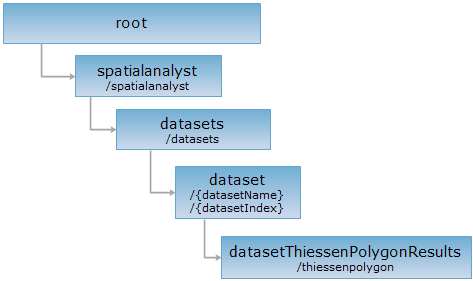
<dataset_uri>/thiessenpolygon[.<format>]
Create Thiessen polygon based on point dataset.
Supported Methods:
Supported output formats: rjson, json, html, xml.

Implement the HTTP request on the following URI, where supermapiserver is the server name, with rjson being the output format.
http://supermapiserver:8090/iserver/services/spatialanalyst-sample/restjsr/spatialanalyst/datasets/SamplesP@Interpolation/thiessenpolygon.rjson
Gets a form for the POST request.
Perform the creating of thiessen polygon operation one.
| Name | Type | Description |
| clipRegion | Geometry | The clip area for the result data can be null, meaning no clipping will be conducted to the result. |
| createResultDataset | boolean | Whether to return the result dataset, return by default |
| resultDatasetName | String | Specify the name of the result dataset. |
| resultDatasourceName | String | Specify the data source that contains the result dataset, the default is the current datasource. |
| filterQueryParameter | QueryParameter | Filter the points in the dataset to analysis, the default is null, that is perform analysis on all the points. |
| returnResultRegion | boolean | Whether to return the polygon region array get by analysis, the default is not return. |
Normal response code(s): 201. The response parameters are as follows:
| Field | Type | Description |
|
succeed |
boolean | Whether the analysis is successful. |
| newResourceID | String | The ID for the analysis result resource. |
| postResultType | PostResultType |
The result type fo the POST request. |
| newResourceLocation | String | The URI of the newly created resource. |
Perform POST request on the http://localhost:8090/iserver/services/spatialanalyst-sample/restjsr/spatialanalyst/datasets/SamplesP@Interpolation/thiessenpolygon.rjson, the request body in rjson format is as the following:
{
"usePoints": false,
"createResultDataset": true,
"resultDatasetName": "testThiessen",
"resultDatasourceName": "Interpolation",
"returnResultRegion": false
}
The respose result returned is as the following:
{
"succeed": true,
"newResourceID": "wbdsm520_f57129dafda2435980eff26bc0c4cabc",
"postResultType": "CreateChild",
"newResourceLocation": "http://localhost:8090/iserver/services/spatialanalyst-sample/restjsr/spatialanalyst/datasets/SamplesP@Interpolation/thiessenpolygon/wbdsm520_f57129dafda2435980eff26bc0c4cabc"
}
Performing a GET request on http://localhost:8090/iserver/services/spatialanalyst-sample/restjsr/spatialanalyst/datasets/SamplesP@Interpolation/thiessenpolygon/wbdsm520_f57129dafda2435980eff26bc0c4cabc can retrieve detailed information about the analysis result. Please see datasetIsoregionResult.
Asks for the response identical to the one that would correspond to a GET request, but without the response body. This is useful for retrieving meta-information written in response headers, without having to transport the entire content. The meta-information includes the media-type, content-encoding, transfer-encoding, content-length, etc.
HEAD request can be used to check if the datasetThiessenPolygonResults resource exists, or if the resource can be accessed by clients. It can also determine if the datasetThiessenPolygonResults resource supports an output format <format> if performed on a URI with .<format> included.